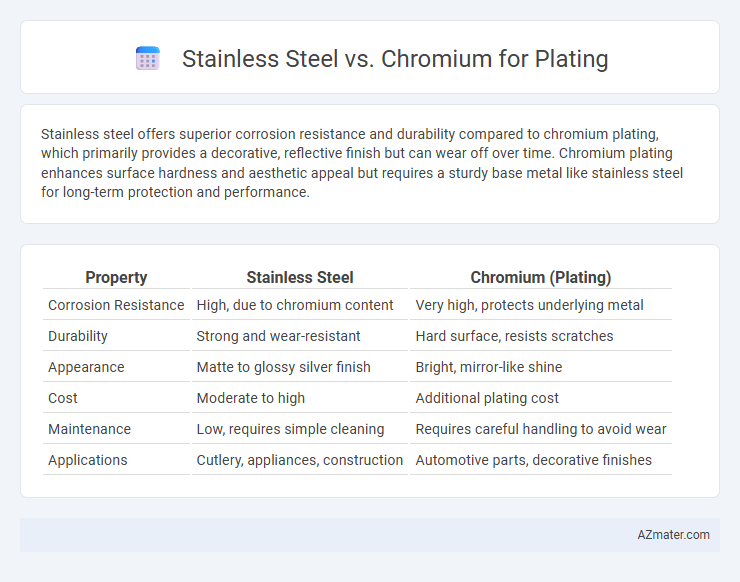Stainless steel offers superior corrosion resistance and durability compared to chromium plating, which primarily provides a decorative, reflective finish but can wear off over time. Chromium plating enhances surface hardness and aesthetic appeal but requires a sturdy base metal like stainless steel for long-term protection and performance.
Table of Comparison
| Property | Stainless Steel | Chromium (Plating) |
|---|---|---|
| Corrosion Resistance | High, due to chromium content | Very high, protects underlying metal |
| Durability | Strong and wear-resistant | Hard surface, resists scratches |
| Appearance | Matte to glossy silver finish | Bright, mirror-like shine |
| Cost | Moderate to high | Additional plating cost |
| Maintenance | Low, requires simple cleaning | Requires careful handling to avoid wear |
| Applications | Cutlery, appliances, construction | Automotive parts, decorative finishes |
Introduction to Plating Materials
Plating materials such as stainless steel and chromium serve distinct purposes in metal finishing due to their unique properties. Stainless steel offers excellent corrosion resistance and durability, making it ideal for structural and decorative applications. Chromium plating provides a hard, reflective surface that enhances wear resistance and aesthetic appeal, commonly used in automotive and household fixtures.
What is Stainless Steel Plating?
Stainless steel plating is a surface treatment process where a thin layer of stainless steel is deposited onto a substrate to enhance corrosion resistance, durability, and aesthetic appeal. This type of plating utilizes the alloy's inherent properties, including chromium content, to create a protective barrier against rust and wear. Stainless steel plating is commonly applied in industries requiring long-lasting, hygienic, and attractive finishes, such as automotive, kitchenware, and medical equipment.
Understanding Chromium Plating
Chromium plating offers a hard, corrosion-resistant surface commonly applied to stainless steel to enhance durability and aesthetic appeal. The process involves electroplating a thin layer of chromium onto the metal substrate, significantly improving hardness and resistance to tarnish and wear. Stainless steel's inherent corrosion resistance combined with chromium plating creates a superior finish ideal for automotive, industrial, and decorative applications.
Chemical Composition Differences
Stainless steel primarily consists of iron, with chromium content typically ranging from 10.5% to 30%, which provides corrosion resistance by forming a passive oxide layer. Chromium plating, on the other hand, involves a thin layer of pure chromium applied to a substrate, offering high hardness, wear resistance, and enhanced corrosion protection. The key chemical difference lies in stainless steel's alloyed chromium integrated into the metal matrix, while chromium plating is a surface coating of elemental chromium.
Durability and Corrosion Resistance
Stainless steel offers excellent durability and corrosion resistance due to its high chromium content, which forms a passive oxide layer protecting against rust and wear. Chromium plating enhances the surface hardness and corrosion resistance of substrates but relies heavily on the base material's properties for long-term performance. In applications requiring sustained exposure to harsh environments, stainless steel typically provides superior longevity compared to chromium-plated metals.
Aesthetic Appeal: Shine and Finish
Stainless steel offers a natural, sleek shine with a smooth matte or polished finish that resists tarnish and scratches over time. Chromium plating enhances aesthetic appeal by providing a highly reflective, mirror-like finish that amplifies brightness and depth, making surfaces appear more lustrous. The choice between the two depends on desired shine intensity and durability, with chromium delivering a more striking visual impact while stainless steel ensures a consistent, long-lasting finish.
Applications and Industry Uses
Stainless steel is widely used in construction, automotive, and kitchenware industries due to its corrosion resistance and durability, making it ideal for structural and decorative applications. Chromium plating provides a hard, shiny surface for automotive parts, tools, and household fixtures, enhancing wear resistance and aesthetic appeal. Industries such as aerospace, electronics, and manufacturing leverage chromium plating to improve component lifespan and performance under harsh conditions.
Environmental Impact and Safety
Stainless steel plating offers superior corrosion resistance and durability with minimal environmental hazards due to its non-toxic composition and recyclability. Chromium plating, especially hexavalent chromium, poses significant environmental risks including toxic waste generation and heavy metal contamination, requiring strict handling and disposal protocols for safety. Both materials impact safety differently; stainless steel is safer to handle and dispose of, while chromium plating demands rigorous protective measures to prevent health risks and environmental damage.
Cost Comparison: Stainless Steel vs Chromium
Stainless steel plating generally incurs lower material and processing costs compared to chromium plating, which involves expensive hexavalent chromium and specialized handling equipment. Chromium plating demands higher energy consumption and stricter environmental controls, contributing to elevated overall expenses. Cost efficiency often leads industries to prefer stainless steel finishes for applications prioritizing budget and corrosion resistance.
Choosing the Right Material for Plating
Stainless steel offers excellent corrosion resistance and durability, making it ideal for plating applications requiring long-lasting protection. Chromium plating enhances surface hardness and provides a bright, decorative finish, but requires a compatible base material to prevent flaking. Selecting the right plating material depends on factors like environmental exposure, mechanical stress, and desired appearance to ensure optimal performance and longevity.

Infographic: Stainless steel vs Chromium for Plating
 azmater.com
azmater.com